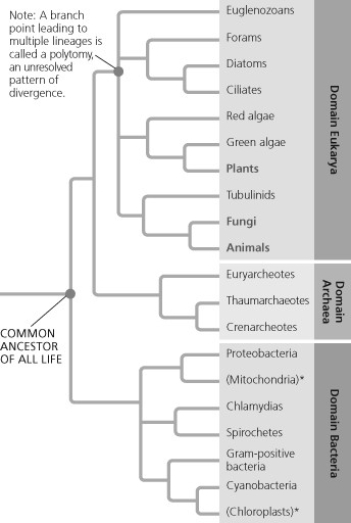
A phylogenetic tree is shown for the three domains of life (Eukarya, Archaea, and Bacteria) . The tree branches in two directions from the first point, labeled Common ancestor of all life. One branch leads in the direction of Eukarya and Archaea, and the other branch leads to Bacteria. The branch leading to Eukarya and Archaea divide, one branch leading to each domain. The branch leading to Eukarya divides into four branches. One leads to Euglenozoans, and the other three lead to branching points. The first leads to Forams in one direction, and another branching point in the other that leads to Diatoms and Ciliates. The second branching point leads to Red algae in one direction, and a branching point that leads to green algae and land plants in the other direction. The third branching point leads to amoebas in one direction, and a branching point that leads to fungi and animals in the other direction. Land plants, Fungi and Animals are all highlighted.
Cyanobacteria were once called blue-green algae because they are photosynthetic. According to the phylogeny shown, the cyanobacteria are more closely related to gram-positive bacteria than to ________.
Definitions:
Fischer Projection
A method to represent the three-dimensional structure of molecules on a two-dimensional plane, emphasizing the configuration of chiral centers.
Fischer Projection
A two-dimensional representation of a three-dimensional organic molecule by projecting bonds from a chiral center, used to depict stereochemistry.
Chiral
Describes a molecule that cannot be superimposed on its mirror image, often resulting in molecules that have different biological activities.
Asymmetric Carbons
Carbon atoms bonded to four different groups, creating a chiral center and leading to possible optical isomerism.
Q7: Which of the following is most likely
Q18: Which of the following describes the most
Q27: Expression of a cloned eukaryotic gene in
Q40: Among the newly discovered small noncoding RNAs,
Q40: Why have biologists hypothesized that the first
Q49: In 2009, a flu pandemic was believed
Q50: In a hypothetical situation, a bacterium lives
Q52: Which of the following viruses would most
Q54: If one organ is an exaptation of
Q75: Branching points at the root of the